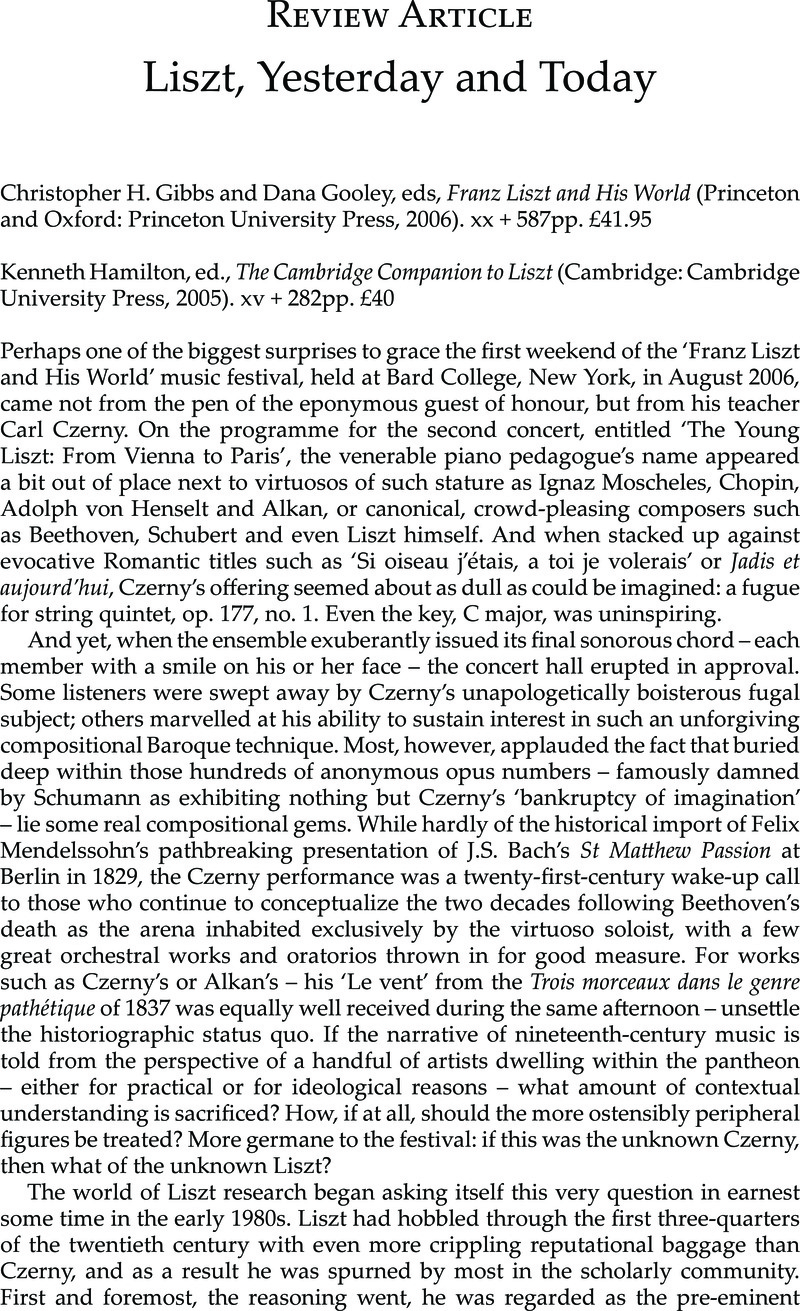No CrossRef data available.
Article contents
Liszt, Yesterday and Today
Published online by Cambridge University Press: 13 April 2011
Abstract

- Type
- Review Article
- Information
- Copyright
- Copyright © Cambridge University Press 2007
References
1 Rosen, Charles, The Romantic Generation (Cambridge, MA: Harvard University Press, 1996): 473.Google Scholar
2 Kerman, Joseph, Musicology (London: Collins, 1985). The American edition, published by Harvard University Press the same year, carried the more provocative title Contemplating Music: Challenges to Musicology.Google Scholar
3 Walker, Alan, Franz Liszt: The Virtuoso Years, 1811–1847 (New York: Knopf, 1983): 29.Google Scholar
4 See reviews by Mueller, Rena Charnin in Journal of the American Musicological Society 37 (1984): 185–96CrossRefGoogle Scholar ; Keiler, Allan in The Musical Quarterly 70/3 (1984): 374–403CrossRefGoogle Scholar ; and Gut, Serge in Revue de musicologie 74 (1988): 81–96CrossRefGoogle Scholar . Walker's, response to Keiler can be found in The Musical Quarterly 71 (1985): 211–19Google Scholar . When Serge Gut released his biography Franz Liszt (Paris: Editions de Fallois/L'Age d'Homme, 1989)Google ScholarPubMed , Walker offered a detailed critique in The Journal of the American Liszt Society 26 (1989): 37–51Google Scholar . More recently, Michael Saffle has criticized several aspects of Walker's complete three-volume project in ‘Lingering Legends: Liszt after Walker’, in Musical Biography: Towards New Paradigms, ed. Pekacz, Jolanta T. (Aldershot: Ashgate, 2006): 89–110Google Scholar . But judging by the position he takes on several issues in his recent Reflections on Liszt (Ithaca, NY: Cornell University Press, 2005)Google Scholar , Walker has not been persuaded by these or any other critics.
5 James Deaville's chapter in CCL, ‘Liszt and the twentieth century’, and Saffle's, Michael recent Franz Liszt: A Guide to Research, 2nd ed (New York and London: Routledge, 2004)Google Scholar nicely dovetail into many of the discussions in FLW and CCL.
6 Fink, G.W., ‘Pianoforte-Werke von Franz Liszt’, Allgemeine musikalische Zeitung 42 (8 April 1840): col. 306.Google Scholar
7 Schumann, , ‘Etüden für das Pianoforte’, Neue Zeitschrift für Musik 11 (24 September and 15 October 1839): 97–8 and 121–3.Google Scholar
8 A notable exception is Jim Samson's Virtuosity and the Musical Work: The Transcendental Studies of Liszt (Cambridge: Cambridge University Press, 2003)Google Scholar , which coincidentally addresses the same works in the context of revision and the work concept.
9 Liszt was clearly elated by Fétis's review. He wrote to his Viennese friend Simon Löwy that ‘Speaking of journals, I am enclosing the article that Fétis (my erstwhile more formidable antagonist) has just published in the Gazette musicale. It has been constructed with great skill and neatly encapsulates the issue.’ The composer then asks Löwy to have Fischhof translate it for Böuerle, the editor of the Wiener Theaterzeitung. See Liszt's letter of 20 May 1841 in Franz Liszt, Briefe, ed. La Mara [pseud. Marie Lipsius] (Leipzig: Breitkopf und Hörtel, 1893), 1: 43.
10 Minor is actually responding to Rehding's argument as presented in the latter's ‘Liszt's Musical Monuments’, 19th-Century Music 26 (2002): 52–72Google Scholar , but Rehding has not altered his conclusions in his CCL contribution.
11 Two companion pieces to Youens's and Hennemann's essays should be mentioned, both by Rena Charnin Mueller: ‘The Lieder of Liszt’, in The Cambridge Companion to the Lied, ed. Parsons, James (Cambridge: Cambridge University Press, 2004): 168–84, andCrossRefGoogle Scholar‘Reevaluating the Liszt Chronology: The Case of Anfangs wollt ich fast verzagen’, 19th-Century Music 12 (1988): 132–47CrossRefGoogle Scholar.


